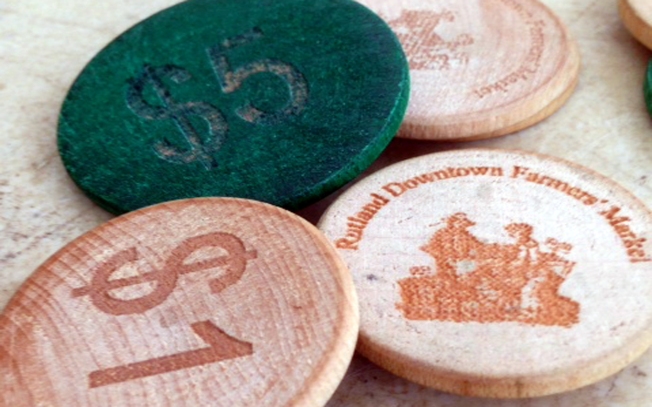By Dan Colton
Since the summer of 2007, efforts throughout Vermont have incentivized participants of the Supplemental Nutrition Assistance Plan (SNAP), formerly known as Federal Food Stamps, to spend their electronic benefit transfers (EBT) at local farmers markets. Farmers market currencies, such as tokens and coupons, are accessible through EBT with the goal of increasing consumption of local, affordable, high-nutrition diets for low-income households. The Farm to Family and Harvest Health coupons are among the plethora of incentives that exist for EBT recipients today.
Harvest Health coupons are available to any EBT recipient and they double the value of an EBT at the market. That’s a 50% credit and one great incentive. However, even though these Vermont taxpayer-funded credits pack twice the punch at a farmers market, less than one percent of Vermont’s EBT were spent at farmers markets during 2013.
EBT at Vermont farmers markets are still experiencing growing pains. Daniel McDevitt, EBT director for the Vermont Department for Children and Families, cites a lack of outreach funding as a key component to community under-involvement, saying that EBT outreach funding in the state budget “is a very small drop, however important it may be.”
Organizers and recipients alike admit most people don’t realize their EBT are being affordably incorporated into farmers markets. “What’s happening is that every year the people that are on 3SquaresVT roll over,” McDevitt admits, referring to the state program which administers federal EBT throughout Vermont. “Next summer comes, a whole new group of people don’t know they can use their cards at the farmers market.”
Sparking a grassroots local-food movement is needed among EBT recipients; at the same time, private taxpayers could be encouraged to voice their support for farmers market EBT, for local farmers and for the local economy. “I hope people will speak to their [legislative] representatives and say that more funding for EBT at farmers markets is needed,” McDevitt says.
Kyle Tremblay, a 30-year-old unemployed man in Rutland, has used EBT for about 18 months. Occasionally he visits the Rutland farmers market, the largest market in the state, to shop on Saturdays.
“It’s just better food,” Tremblay says. “I know where it’s been grown, and, you know, it’s food stamps—so it’s taxpayers money—so it’s going back into something that’s in the state. I feel a lot better about that.”
But he sees the vast majority of EBT recipients avoiding markets because they aren’t familiar with affordability efforts and thus feel financially incapable. He also says that many recipients prefer to spend their monthly EBT on one large purchase at a chain store rather than from local farmers markets.
Angela Smith-Dieng, an advocate working with the Vermont Department for Children and Families, says that only a fractional percentage of Vermont’s annual EBT allocation of roughly $120 million was spent at farmers markets during 2013. “$86,824 was spent at markets [during 2013],” Smith Dieng says, and with over $120 million coming in yearly, “the vast majority of benefits are spent at large retailers.” To put that ratio into perspective – let’s just say that many basic calculators aren’t able to express a decimal that minute without employing a lot of zeros, a negative sign, and scientific notation.
But Smith-Diegn says there is a bright side. “The good news is when we look at 2013 compared to 2012, we saw a 12 percent increase in EBTs spent at farmers markets. And we’re hoping to obviously increase that percentage each year.”
Farmer Lindsay Courcelle, of West Rutland’s Alchemy Gardens, says that the cumulative effects of the EBT programs are more noticeable on the ground at her stand than what the numbers may convey. “When the coupons started coming out, you see those new people.” Courcelle notices many customers are exchanging their EBT tokens and coupons for the kind of everyday produce—like tomatoes, cucumbers, and squash—which often saves EBT users more money than at the supermarket. Courcelle’s farm even allows EBT to be used for community supported agriculture shares, though she isn’t positive if any other farms offer the same service.
And then there are other obstacles facing market accessibility for EBT users. For starters, farmers markets aren’t open daily, and when they are open, many people don’t know the schedule. Many are simply unaware that the market even accepts EBT or if they are aware, they may be unsure of how to go about using their benefits. Transportation to rural markets also imposes constraint on many low-income households.
“These kinds of programs take a long time for the outreach to really spread throughout a community and for people to change their behaviors and shopping habits,” Smith-Dieng says. “We’ve only had EBT at Vermont markets since 2007. The fact we are only at $87,000 [in July] isn’t a big deal. We’ve seen a lot of change, we just need a lot more.”
“I think we’ll get there,” she adds, “it just takes a sustained commitment from the community members and partners.”
Dan Colton is a beginning farmer and journalism student concerned with the security of healthy foods for everyone.
